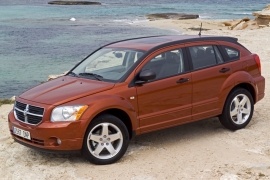DODGE Caliber Models/Series Timeline, Specifications & Photos
First production year: 2006
Engines: Gasoline, Diesel
Body style: Hatchback
Sharing its platform with the Jeep Patriot and the Jeep Compass, the Caliber was a bold move made by Chrysler into the compact crossover segment.
In 2006, Daimler and Chrysler were still under the same roof, but there were significant troubles in their marriage. Chrysler's sales were plummeting, and it needed a quick fix since its German partner didn't like this. As a result, it used the same platform developed together with Mitsubishi in 2004 that was used to create the Jeep Patriot and the Jeep Compass and made the Caliber. This should have filled the automaker's pockets fast. In addition, it tried to lower the sale price of this hatchback-on-stilts vehicle so it could sell it in large numbers. As a result, Dodge unveiled the new model in 2006 as a 2007.
Dodge's styling was noticeable, especially at the front, where the crosshair grille stood flat and vertical. The retro-design inspiration was obvious since the Caliber featured a taller hood than the car's fenders, an element previously seen on the Durango and on the Ram's first generation. A set of round fog lamps was installed below the bumper, depending on the grade. Dodge sold the car in a few trim levels: the SE, the SXT, and the R/T. Above them was the punchy and powerful SRT4, which many people considered to be a completely different kind of animal from its siblings.
The Caliber came as a replacement for the Dodge Neon and the Crysler PT Cruiser. It carried over some of the ideas from the latter but enhanced well enough to make people like it. First, the enlarged fenders in all corners were less prominent but still had a muscular look. Then, the ascending beltline created a dynamic image for the car. Despite some angular shapes of the Caliber, the greenhouse boasted an arched line sloped down behind the C-pillars and sported a third row of windows behind the rear doors. Dodge provided the vehicle with standard alloy wheels for all grades, and that convinced people to buy it.
Inside, the design was clever, with high-mounted seats and a binocular-styled instrument panel where the dials were integrated into individual clusters. The center stack housed the stereo and the HVAC controls, while Dodge placed the gear stick and a couple of cup holders on the center console. An adjustable armrest concealed a storage underneath it between the front seats. In the back, there was enough room for three adults. Unfortunately, the Caliber's main disadvantage was its interior materials. The hard-plastic areas and the upholstery were below the industry's average.
Under the hood, the automaker installed a choice of gasoline engines. Across the pond, in Europe, the Caliber was available with a turbo-diesel engine supplied by Volkswagen. In the U.S., the automaker installed a CVT for the SXT grade, which was unpleasant to drive. It did its job but was noisy. Dodge sold the Caliber in over 400,000 units worldwide, including in Japan and Australia. But it was too late to save the Daimler-Chrysler marriage.
